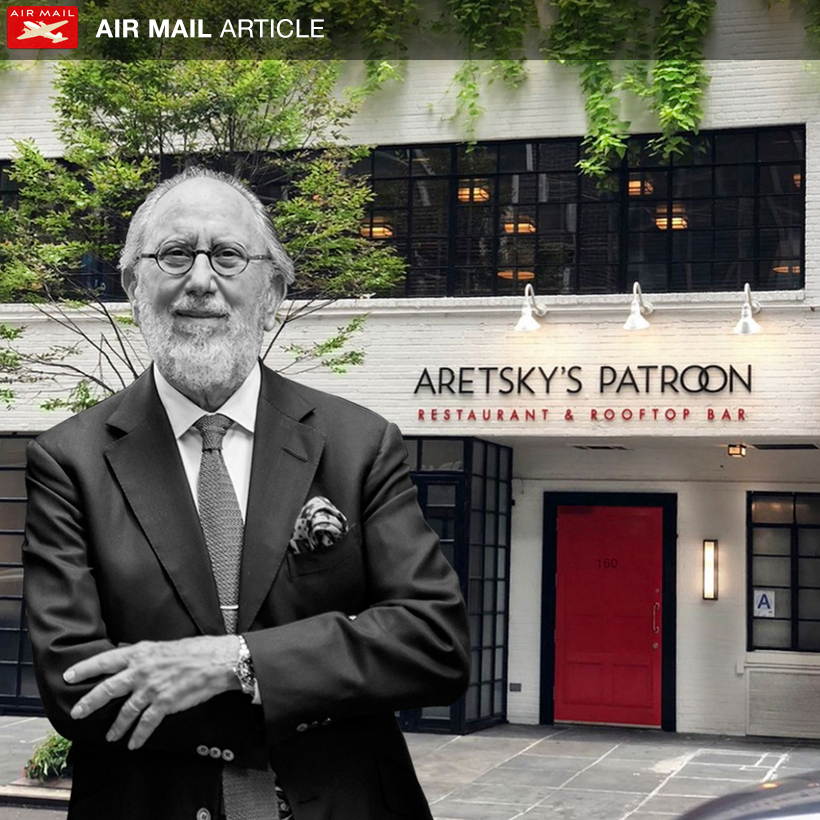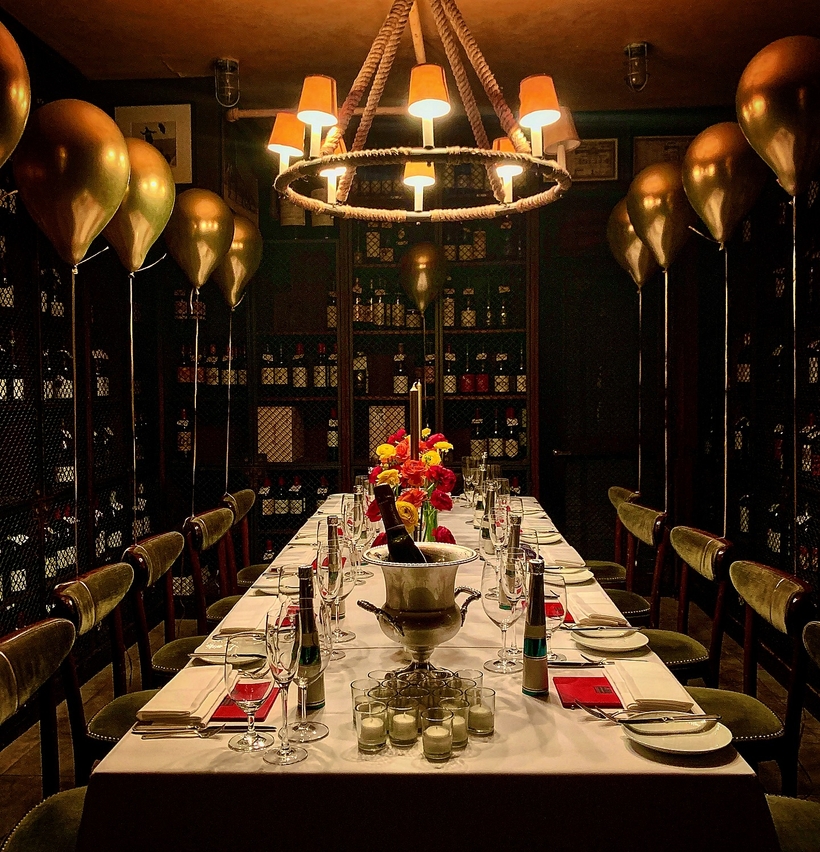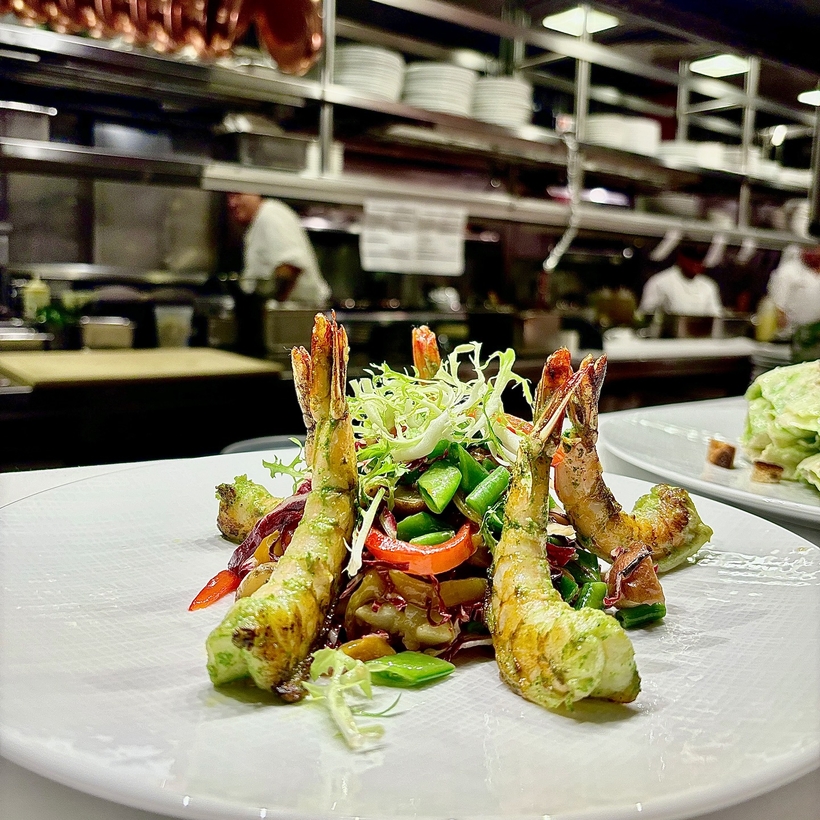The Last Front-of-House Man

For five decades, Ken Aretsky has defied New York restaurant odds by making charm, simplicity, and elegance the first orders of business.
Ken Aretsky, natty in a bespoke suit, trim beard, and elegant eyeglasses, greets his guests with the ease of a man who knows his place in the world. His place, as it happens, really is his place—Aretsky’s Patroon, on East 46th Street—where he’s been circulating through a dining room full of power players for nearly 30 years.
The history of dining in New York is not just the history of food but also of business, media, celebrity, and real estate. And Aretsky’s path intersects with them all. “I’ve been working in restaurants for five decades,” Aretsky says. That’s a lot of mayors, Yankees managers, and dining trends.
Long before the Food Network, social media, and celebrity chefs, you went to a restaurant because of the owner. Diners could expect to be greeted by Elaine at Elaine’s, or by Sirio at Le Cirque. “They would whisk you to your table in the corner,” Aretsky recalls. “If you weren’t in favor, it was the long walk to Siberia.”

Aretsky was born on the Lower East Side and has always been in the restaurant business. His parents ran a soda-supply service, and as a boy he would visit different diners and steak houses on delivery runs. A family friend hired him as a summer busboy at Lenny’s Steakhouse on Long Island. Later, he ran Truman’s, also on Long Island. “We were very busy once Newsday gave us four chef’s hats,” he recalls.
In 1976, recently divorced, he moved to Manhattan and took a brief, unfortunate turn in finance. “The Dow was at 600,” he laughs. “And I was the worst stockbroker in New York.”
By 1978, Aretsky wanted to open a place of his own, and for the first time—but not the last—the real-estate gods smiled down on him. One Friday night he walked past a darkened but handsome bar on Third Avenue between 84th and 85th Streets. “There was a small piece of paper attached to the door with a phone number,” Aretsky remembers.
He went to a pay phone and the owner answered. The restaurant was available. Aretksy borrowed $5,000 from his mother and signed the lease before his partner, Steve Orenstein—a sportscaster known to his friends as Oren—even saw the space.

Oren & Aretsky opened in late 1978. “It was an Irish bar,” Aretsky says. “We did very little but add chops to the menu—we envisioned it as a JG Melon further uptown.” The rollout was not a smooth one. “People didn’t come,” he says. They resorted to paying a friend’s limousine driver to park his car out front to add some allure.
It was a hockey player, of all people, who saved them. Dave Maloney, a Rangers defenseman, lived in the area and became a regular. “The team was playing terribly and he could eat in peace.” Pretty soon the rest of the team came for dinner. Then the Rangers started playing well, making it all the way to the Stanley Cup that year, and Oren & Aretsky became known as an athletes’ hangout.
But in late-1970s New York, one athlete mattered more than the rest. “Once Reggie Jackson came it was never the same.” Models such as Carol Alt and Cheryl Tiegs followed, along with a glamorous crowd who would have dinner before heading to Studio 54. Many nights, Aretsky joined them. “I thought I was in a dream,” he remembers.
Tired of the intense nightlife, Aretsky started looking for a slower pace. He sold his share to Orenstein and opened Arcadia on East 62nd Street, with Anne Rosenzweig as head chef. The restaurant helped establish the popularity of seasonal American cuisine and did exceptionally well. So well that when Marshall Cogan bought the ‘21’ Club, in 1985, Aretsky became the legendary restaurant’s general manager while retaining his stake in Arcadia. Even though Aretsky and Rosenzweig didn’t always see eye to eye, they worked together and revamped the ‘21’ Club.

New life was breathed into the old-guard hangout, and ‘21’ thrived—it attracted young, up-and-coming patrons such as Mike Bloomberg, who negotiated for an early Bloomberg Terminal to take the place of the old stock ticker at the restaurant.
By 1995, Aretsky was ready to leave ‘21’ and run his own restaurant again. He started searching for a new space. “If you want to find a place for restaurants, you have to walk the streets.”
So there he was, on 46th Street, when he found Christ Cella, a steak house in a three-story building. “It was perfect,” he recalls. Everything was built out; there were private rooms on the second floor and staircases in back so he could send food up without disturbing the dining room. He bought the building.
“I wanted to create a warm environment and serve the kind of food I want to eat,” he says. That type of unfussy food does not involve a menu that has to be explained or a dish that Chef suggests be eaten counterclockwise. It means well-made classics like dry-aged côte de boeuf, a veal chop, and tuna tartare.

After decades, Aretsky says, a few things remain true. “People want to come in, to feel welcome and feel recognized.” If they come a lot then their list of demands, particularly in New York, goes up. “They want their favorite tables, and if they’re here three times a week, they’re going to get it.”
Patroon is a rare thing these days: an elegant family restaurant. Aretsky’s lovely wife, Diana, who was a longtime marketing executive at Tiffany & Co., now helps out with operations. Their son Gene, tall and dapper, can be found greeting diners most nights. (One daughter, Beth, is also in the industry—she’s a former private chef who now works at Wildflower Farm in Gardiner, New York.)
All the help allows Aretsky to spend more time at his house in the Catskills, a short drive from the Beaverkill River, where he fishes with a coveted Per Brandin bamboo fly rod. (“My collection has not stopped growing.”)
There’s talk of writing a memoir. But Aretsky still finds his way back to the dining room. He can’t help it, he says.
“This is where I belong.”
_________________________________
Original article For Air Mail, click below to read full original article at Air Mail.
BY DAVID COGGINS
AUGUST 17, 2024
David Coggins is the author of four books, including The Optimist and The Believer: A Year in the Fly Fishing Life.